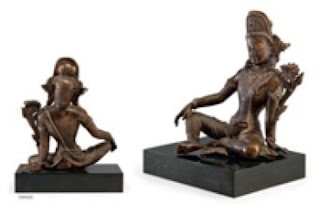
Indian antiquities have a good market abroad but we ourselves cannot buy them... A look at why

There is continued interest among American buyers - private individuals and institutions - in bronzes and copper artifacts as evidenced by purchases of a Bronze Figure of 'Balakrishna' from South India, Tamil Nadu (Chola Period, 12th century) as also a Copper Figure of Indra (Nepal, 14th/15th century). Few months back, each of these sold for USD 122,500 (INR 5.6 million) at a price higher than auctioneer Christie's estimate.
Both these art pieces - the Chola bronze (16-1/2 in. or 42 cm high) and Indra (10-3/4 in. or 27.2 cm high) were bought by America-based bidders. Interestingly, even if they wished to, art lovers of Indian origin based in India could not have bought these rare pieces. Reason: embargos by the Indian government following the passing of the Archeological Survey of India's Antiquities Act of 1972.
This writer asked two gallery owners - one from New York and the other from Bangalore - the same question: How come bronzes tend to be purchased mostly by western art lovers or U.S. institutions, not say by investors of Asian origin?

Manhattan Gallery owner Deepak Talwar says, "Perhaps Western buyers and institutions tend to prefer antiquities in view of the provenance and restrictions by the Indian government in owning antiquities. It is also possible American institutions and collectors want to buy Asian antiquities as they have little of their own art and antiquities from 500 or say, 1,000 years ago."
M. Maher Dadha, Chairman & Managing Director of a Bangalore gallery, Bid & Hammer Auctioneers (P) Ltd., laid out additional reasons: "Firstly, Indians are skeptical of buying Bronzes, Copper or Mixed Alloy statues, especially of Hindu gods and goddesses, as they are considered sacred. Secondly, most of the ancient stone statues being offered are either partially damaged or broken while excavating. In such instances, owning a broken or damaged statue is considered very inauspicious by the owner. In other words strong religious and cultural beliefs are detrimental factors."
Indians are unable to buy items here. Since reportedly most of the statues or bronzes have been stolen from temples and illegally smuggled out of India before the 1972 Act became effective, art lovers here just cannot buy them even if they travel abroad to do so.
Dadha adds, "The Indian government could actually now afford to bring back priceless, historically significant items of Indian heritage like some other governments do but the political will is lacking."
(A New York based independent trend writer, Raj S. Rangarajan reports on the art market and auto shows and reviews films for media based in New York; Toronto, Canada; and India.)
talktoretailplus@yahoo.com
RAJ S. RANGARAJAN